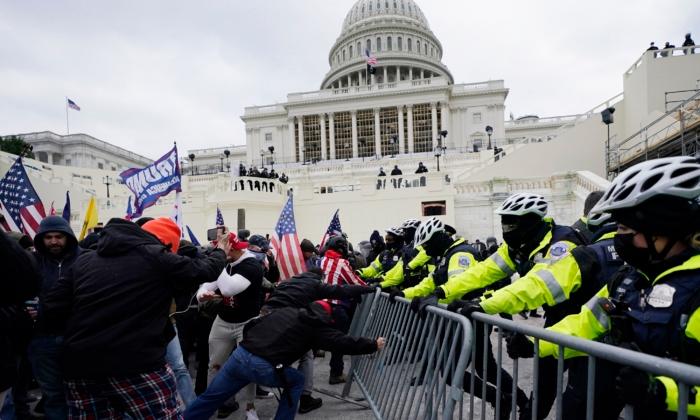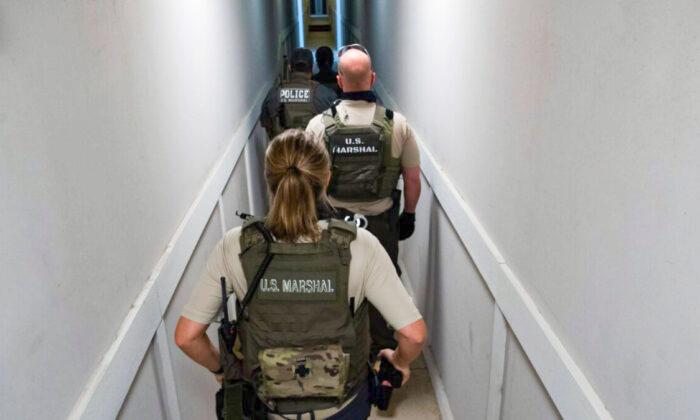An Indiana woman was put on probation on June 23 in the first sentence stemming from the Jan. 6 breach of the U.S. Capitol building.
Under a deal with prosecutors, the government dropped three other misdemeanor charges against Morgan-Lloyd, as she “did not personally engage in physical violence against law enforcement or destroy any government property.” She has since apologized to “the American people” for participating in “a savage display of violence.”
“I would just like to apologize to the court, the American people, and my family,” she said in remarks to U.S. District Judge Royce Lamberth. “I went there to show support for President Trump peacefully, and I’m ashamed that it became a savage display of violence.”
Morgan-Lloyd stated that she felt “ashamed that something meant to show support for the President had turned violent.”
“At first, it didn’t dawn on me, but later I realized that if every person like me, who wasn’t violent, was removed from that crowd, the ones who were violent may have lost the nerve to do what they did,” she said.
“For that, I am sorry and take responsibility. It was never my intent to help empower people to act violently.”
Immediately following the breach on Jan. 6, she had described the events in a Facebook post as the “best day ever” after storming the Capitol building. She said that her friend and she “were in the first 50 people in.”
Court documents note that while Morgan-Lloyd faced a maximum potential sentence of six months in prison, a probationary sentence of three years—along with certain conditions—is an “appropriate” sentence in light of the facts and circumstances surrounding her actions leading up to and on the day of the Capitol breach.
Morgan-Lloyd didn’t engage in any preplanning or coordination prior to her entry into the Capitol, didn’t personally engage in acts of violence or destruction of property, or incite the same, court papers state.
The 49-year-old remained in the Capitol for only “a little over ten minutes” and in a limited area of the building; cooperated with law enforcement at the time of arrest, including submitting to a voluntary interview and search of her cell phone; admitted to and accepted responsibility for her actions in a timely manner; expressed contrition; and she didn’t have a criminal history.
In seeking probation for Morgan-Lloyd, prosecutors also noted that she was invited by her hairdresser friend, Dona Sue Bissey, 52, to drive to Washington to hear former President Donald Trump speak.
Prosecutors said in court records, however, that her “storming” of the building was a “serious violation of the law.”
“I have really struggled with what would be an appropriate sentence,” Lamberth said. "This wasn’t a peaceful demonstration. It was not an accident that it turned violent.”
In her plea, Morgan-Lloyd said that she’d learned from her actions and had been given a list of books and movies by her attorney, H. Heather Shaner, which were meant to help her “see what life is like for others in our country.”
“I’ve learned that even though we live in a wonderful country, things still need to improve,” Morgan-Lloyd wrote. “People of all colors should feel as safe as I do to walk down the street.”
Morgan-Lloyd’s remorse in the aftermath of the Capitol breach was acknowledged by the prosecution.
“To be clear, what the Defendant initially described as ‘the most exciting day of [her] life’ was, in fact, a tragic day for our nation—a day of riotous violence, collective destruction, and criminal conduct by a frenzied and lawless mob,” Assistant U.S. Attorney Joshua S. Rothstein said in court. “However ... [Morgan-Lloyd’s] seeming prior bravado ... appears to have been tempered by a realization of the consequences of her actions.”
In the past two weeks, four other people—a Tennessee man, a Maryland man, and a Virginia couple—pleaded guilty to the same misdemeanor charge.
Testifying at an oversight hearing held by the House of Representatives Judiciary Committee earlier this month, FBI Director Chris Wray said that the FBI had divided the tens of thousands of protesters who were at the Capitol on Jan. 6 into three groups: “peaceful, maybe rowdy” protesters who didn’t participate in the breach and made up the biggest group, a second group who engaged in criminal trespass of the Capitol Building, and a third group—the smallest in number—who were responsible for carrying weapons into the Capitol.
Close to 500 arrests among those in the second and third groups have been made so far in connection with the Jan. 6 incident, Wray told the committee. The Department of Justice previously said that the majority of cases are related to entering a restricted building, obstruction of an official proceeding, and civil disorder.
The FBI director also testified that the law enforcement agency considered the events that unfolded on Jan. 6 to be an act of “domestic terrorism.” When asked by Rep. Eric Swalwell (D-Calif.) whether the events on Jan. 6 at the Capitol could be considered an “insurrection,” Wray replied that he believes that it would be inappropriate to describe the breach as such.
“In my role as FBI director, because that’s a term that has legal meaning, I really have to be careful about using words like that,” Wray said, noting that what he says could affect ongoing criminal cases.
Democratic lawmakers have pushed the narrative that the Jan. 6 breach was an “insurrection,” largely during the January impeachment effort against the former president. No one who participated in the breach has been charged with insurrection.





